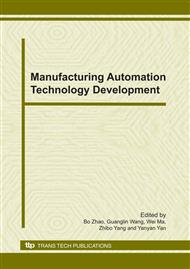p.444
p.449
p.454
p.458
p.462
p.467
p.472
p.476
p.481
Development of On-Line Automatic Monitoring System for the Steel Belt Conveyor
Abstract:
The on-line automatic monitoring system is self-developed for steel cord conveyor belt. It is based on weak-magnetic field constant nondestructive testing technologies and adopted the sensor array with horizontal and vertical transducers to fully guarantee the fault location accuracy and amplitude accuracy. The TCP and UDP network transport protocol is used in this system, which achieves the real-time communication, data saving and image reconstruction. Different feature fault signal of steel wire is extracted and identified automatically. So the quantitative detection and location detection are realized for various steel cord failures such as rope broken, rust corrosion, joint dislocation, crushed, tilt and so on.
Info:
Periodical:
Pages:
462-466
Citation:
Online since:
December 2010
Price:
Сopyright:
© 2011 Trans Tech Publications Ltd. All Rights Reserved
Share:
Citation:


